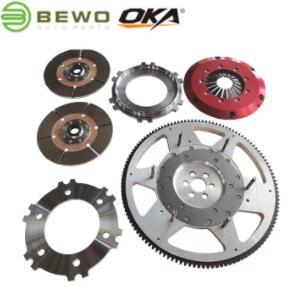The flywheel is the mounting surface for the clutch. The clutch pressure plate is bolted to the flywheel surface. The clutch plate is clamped and held to the flywheel by the spring action of the pressure plate. The surface of the flywheel is precisely machined and the surface is smooth. The surface of the flywheel in contact with the clutch disc is made of iron. Even though the flywheel is aluminum, the surface is iron because it wears well and dissipates heat better.
The flywheel is connected to the crankshaft of the engine through bolts. The surface of the flywheel facing the gearbox is used as the friction surface of the clutch-driven plate, and the clutch cover is fixed on this surface with bolts and rotates accordingly. A socket bearing is installed in the center of the flywheel, which is located at the front end of the gearbox main shaft and allows for a speed difference between the two components. This bearing (guide bearing) can take the form of a sliding bushing ball race (aligned with the axis). The clutch guide bearing is part of the drivetrain and is located at the end of the crankshaft and in the center of the flywheel. The transmission input shaft is connected to the center of the flywheel through a clutch guide bearing. With the help of the bearings, the relative motion between the transmission input shaft and the flywheel becomes smooth and power loss is zero.
Flywheels are often used to provide continuous energy in systems with discontinuous energy sources. In this case, the flywheel stores energy when the energy source applies torque and releases the stored energy when the energy source does not apply torque to it. For example, a flywheel is used to maintain a constant angular velocity of the crankshaft in a reciprocating engine. In this case, a flywheel mounted on the crankshaft stores energy when the firing piston is applying torque and releases energy to it when no piston is applying torque to it on mechanical load. The hot gas expands, pushing the piston to the bottom of the cylinder. The piston returns to the top of the cylinder (top dead center) through the flywheel. Flywheels are often used to ensure smooth rotation or to store energy to carry the engine through the unpowered part of the cycle.
Flywheel construction may vary in material and design. Lighter, harder alloys are more likely to be used in high-performance cars, while the most common material in regular cars is cast iron. Aluminum and forged steel are also used. Carbon fiber flywheels are also currently being developed for racing applications, but these are very expensive and can only be seen in super exotic factory cars.
Taizhou Benwo Auto Parts Co., Ltd. A Clutch Cover Manufacturer from China. The company's main business is Heavy Duty Truck Clutch, providing Truck Clutch Disc
